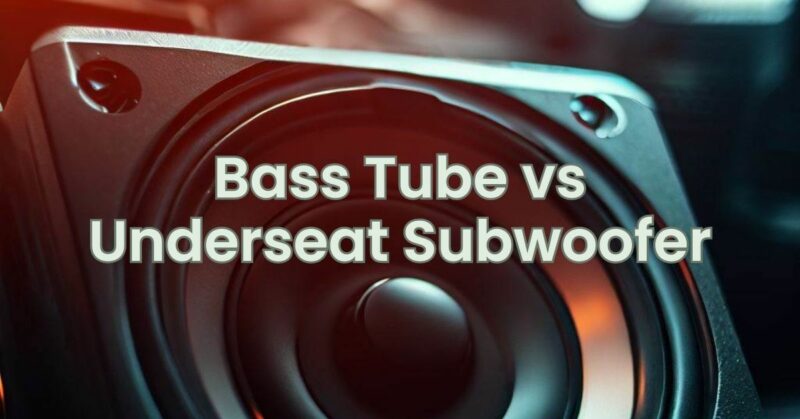When it comes to enhancing the bass performance in your car audio system, two popular options are bass tubes and underseat subwoofers. Both solutions are designed to provide an immersive low-frequency experience without compromising valuable space in your vehicle. In this article, we will compare bass tubes and underseat subwoofers, highlighting their features, benefits, and considerations to help you determine which option is best suited to your car audio needs.
Bass Tube:
A bass tube is a cylindrical enclosure that houses a subwoofer driver. Here are some key points to consider about bass tubes:
- Space Efficiency: Bass tubes are designed to maximize space efficiency. Their compact cylindrical shape allows them to be easily installed in various locations within your vehicle, such as the trunk, behind seats, or in cargo areas. They are ideal for smaller vehicles or situations where trunk space is limited.
- Bass Performance: Bass tubes can produce deep and punchy bass. While they may not provide the same level of bass extension and accuracy as larger subwoofers, they are capable of enhancing the low-frequency response of your car audio system.
- Easy Installation: Bass tubes are relatively simple to install and require minimal wiring. They often come with built-in amplifiers, making the setup process easier and eliminating the need for additional equipment.
Underseat Subwoofer:
An underseat subwoofer is a compact subwoofer specifically designed to fit under a car seat or in other tight spaces. Here are some key points to consider about underseat subwoofers:
- Space Optimization: Underseat subwoofers are designed to maximize space utilization. They are slim and compact, allowing them to be conveniently installed under seats or in other unobtrusive locations. This design ensures that you can still enjoy enhanced bass without sacrificing valuable space in your vehicle.
- Bass Performance: Despite their small size, underseat subwoofers can deliver impressive bass performance. They are engineered to produce deep, impactful bass notes that add depth and richness to your music. While they may not provide the same level of bass output as larger subwoofers, they offer a balance between space-saving design and enhanced audio quality.
- Easy Integration: Underseat subwoofers are designed for seamless integration into your car audio system. They often come with built-in amplifiers and feature easy wiring options, simplifying the installation process and minimizing the need for additional components.
Considerations for Both Options:
- Space Requirements: Assess the available space in your vehicle and determine whether a bass tube or underseat subwoofer would be a better fit. If trunk space is limited, an underseat subwoofer can be a space-saving solution. However, if you have more room to spare, a bass tube might provide a slightly better bass performance.
- Power Requirements: Consider the power requirements of each option and ensure compatibility with your car’s electrical system. Check the power ratings of the subwoofer or bass tube and ensure that your amplifier can adequately drive the chosen option.
- Sound Preferences: Take into account your personal sound preferences and the type of music you typically listen to. If you prioritize deep bass extension and higher volume levels, a bass tube or a larger subwoofer might be more suitable. If you prefer a well-balanced sound with space-saving convenience, an underseat subwoofer could be a better choice.
Deciding between a bass tube and an underseat subwoofer ultimately depends on your space requirements, desired bass performance, and personal preferences. Bass tubes excel in space efficiency and offer decent bass enhancement, while underseat subwoofers optimize space utilization without compromising audio quality. Consider your vehicle’s space constraints, desired bass output, and installation convenience to make an informed decision that will elevate your car audio experience.


